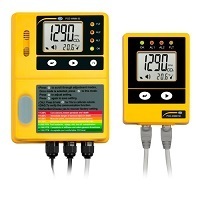
analyzer
The pharmaceutical, chemical, food, food, oil, gas, petrochemical, and صنایع industries need measurement techniques to make their processes effective. From ancient times, the sample process was sent to the laboratory for analysis.
It is clear that there is time to send and test the damage to the production process in order to minimize the time interval between the extraction of results and decision-making to control the process. Hence the chemistry of the Pab process analysis.
Process decomposition chemistry is actually a modified form of decomposition chemistry techniques for use in process environments. In this case, an analyzer is used instead of laboratory devices.
Analyzers are considered as the armed eye of the oil industry in operational processes and their widespread use is required in the oil industry. Considering that there may be more than one hundred analyzers in one refinery unit, The proper performance of the analyzers depends.
To monitor the concentration of analytes and also to observe the laws of environmental protection, it is necessary to measure them. For example, we can measure the amount of oxygen required for combustion in furnaces and boilers, which should be at a certain level. Incomplete combustion and production of environmental pollutants such as soot.
On the other hand, if the amount of oxygen exceeds the required range, the release of hot unburned oxygen causes a loss of thermal energy. Other examples in this field include the output of sulfur recycling unit stacks in oil and gas refineries. The fact that large amounts of sulfur gases such as sulfur dioxide are released into the atmosphere, no doubt monitoring this amount of emissions and compliance with the permitted limit by the environment, highlights the issue of analyzers.
History
The use of process analyzers dates back to about 75 years ago when the first non-scattering infrared photometer (used to measure carbon monoxide and carbon dioxide) was made at the Ludwig Hoffen Research Laboratory. The use of process analyzers by American chemical and petroleum companies It dates back to the 50s.
During the 1960s, about $ 10 million to $ 15 million worth of gas chromatographs installed by Beckman, PerkinElmer, and Greenbrier companies were in second place, while second-line online analyzers sold non-scattering infrared analyzers at a cost of $ 8 to $ 12 million by Beckman companies. And Liston Becker was done.
The advent of fast digital computers in the 1960s and the subsequent dramatic change in microelectronics, microprocessors in the 1970s led to a huge revolution in process analyzers. Product quality have been.
Rose Calibration Company in Melbourne, Australia with over ten years of experience provides all calibration, maintenance, and repair services throughout Australia. If you live in Sydney, Melbourne, Adelaide, Perth, Geelong, and Brisbane, you can receive your quote in less than two hours by fill-up the form via the “Booking” link.

